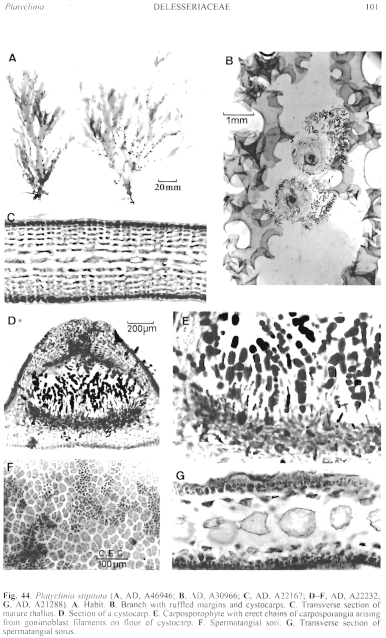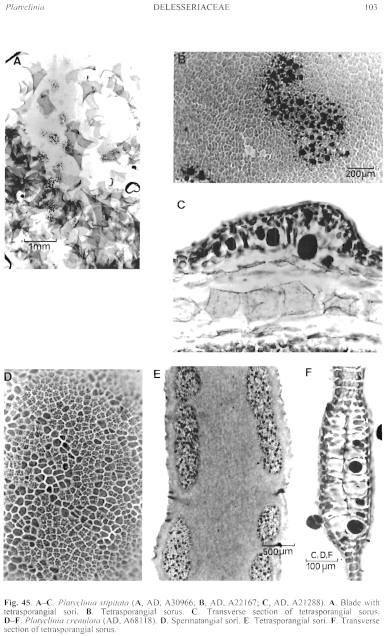|
|
|
|
|
|||||||||||
|
Electronic Flora of South Australia Species Fact Sheet
Phylum Rhodophyta – Family Delesseriaceae
Selected citations: De Toni 1900: 669. Guiler 1952: 102. Kylin 1924: 64, fig. 49. Lucas 1909: 36; 1929a: 20. Lucas & Perrin 1947: 226. May 1965: 402. Wynne 1983: 446; 1996: 181; 1997: 330.
Synonyms
Platyclinia purpurea J. Agardh 1898: 109. De Toni 1900: 670. Kylin 1924: 66, fig. 51. Lucas 1909: 36. Lucas & Perrin 1947: 226. May 1965: 402.
Nitophyllum crispatum sensu J. Agardh 1898: 110 (NON Hooker & Harvey in Harvey & Hooker 1845: 185, pl. LXXI fig. 1).
Neuroglossum ?crispatum (J. Agardh) J. Agardh 1899: pl. 2 fig. 8.
Platyclinia crispata (J. Agardh) J. Agardh ex De Toni sensu Kylin 1924: 66, fig. 52. Lucas 1909: 36. May 1965: 402. [NON De Toni 1900: 670 = Myriogramme crozieri (Hooker & Harvey) Kylin 1924: 59 from southern S. America.]
Platyclinia kylinii Papenfuss 1967: 102.
Thallus (Fig. 44A) complanately and irregularly laterally branched, 10–30 cm high, branches tapering to apices and mostly basally constricted, 5–15 (–50) mm broad and 180–350 µm thick, margin entire and wavy to slightly or strongly crisped (Fig. 44B) or with branched spinous clusters, especially on the lower thallus; midrib and lateral veins absent. Holdfast discoid, becoming divided, 0.5–1 mm across; epiphytic (on Heterozostera and various algae) or epilithic. Structure. Growth marginal, without distinct apical cells, intercalary cell divisions frequent, thallus monostromatic near apices, soon becoming polystromatic. Cross section of thallus (Fig. 44C) with regular cell arrangement, a central layer of large cells 40–110 µm thick, overlain by 1–2 (–3) layers of smaller cortical cells (slightly thicker centrally in branches), inner 2 cortical layer cells usually dimidiate, the inner cortical cells 35–55 µm across, outer cells (10–) 15–30 µm across, isodiametric to L/D 2. Mature cells multinucleate; rhodoplasts discoid.
Reproduction: Gametophytes dioecious. Procarps (Fig. 54A) scattered on both sides of blades, with the primary cell cutting off a cover cell and a supporting cell which produces 2 sterile cells and a 4-celled carpogonial branch. Carposporophytes (Fig. 44D) with radiating filaments of cells forming a weft on the floor of the cystocarp, connected to the plate of primary cells by prominent pit-connections, and producing erect filaments (Fig. 44E) bearing chains of 3–5 ovoid to isodiametric carposporangia 25–45 µm in diameter, maturing together. Cystocarps (Fig. 44B) scattered, swollen and protuberant on one side of the blade, 1–1.5 mm across; pericarp ostiolate, 5–8 cells thick on sides, with a thicker collar 10–12 cells thick around the ostiole. Spermatangial sori (Fig. 44F) vague, scattered, slightly raised, with the cortical cells producing initials each cutting off several elongate spermatangia (Fig. 44G).
Tetrasporangial sori (Fig. 45A, B) small, circular to oval and 0.5–1 mm across, scattered but closely adjacent, slightly raised with the cortical cells producing paraphyses 3–4 cells long with terminal cells ovoid to obconical and 12–20 across. Tetrasporangia cut off from lower cells of paraphyses (Fig. 45C), subspherical to ovoid, 45–75 µm in diameter.
Lectotype from Port Elliot, S. Aust. (Hussey); in Herb. Agardh, LD, 31103.
Selected specimens: Waterloo Bay (Elliston), S. Aust., on Metagoniolithon, 4 m deep (Shepherd, 26.ii.1978; AD, A54992). Elliston, S. Aust., drift (Womersley, 27.ii.1959; AD, A22167). Point Avoid, S. Aust., drift (Womersley, 2.xii.1975; AD, A46946). Wanna, S. Aust., on Callophyllis, drift (Shepley, 19.ii.1959; AD, A22232) and (Ricci, 13.ii.1994; AD, A63360). West Bay, Kangaroo I., S. Aust., on Sargassum, drift (Womersley, 6.i.1946; AD, A2230). Seal Bay, Kangaroo I., S. Aust., drift (Mitchell, 29.x.1966; AD, A30966). Pennington Bay, Kangaroo I., S. Aust., drift (Womersley, 27.i.1946; AD, A2885). Young Rocks, S of Kangaroo I., S. Aust., 16–30 m deep (Branden, 18.vi.1991; AD, A61443). Robe, S. Aust., on Heterozostera, drift (Womersley, 18.viii.1957; AD, A21288). Blackfellows Caves, SE S. Aust., epiphytic, drift (Womersley, 26.xi.1999; AD, A68373-"Marine Algae of southern Australia" No. 409). Port MacDonnell, S. Aust., on Laurencia filiformis, drift (Kraft, 1.xii.1991; MELU, K8749). Bridgewater Bay, Vic., drift (Womersley, 14.iv.1959; AD, A22617).
Distribution: Elliston, S. Aust., to Bridgewater Bay, Victoria.
Taxonomic notes: Platyclinia stipitata appears to be a rare species confined to rough-water coasts. The margins vary from slightly crispate to strongly so, becoming dentate with branched outgrowths on lower parts; this is well shown in A46946 and A68373 where upper parts are largely entire. Some plants (e.g. A30966, some of A68373) have entirely crispate-dentate margins as described for N. crispatum sensu J. Agardh (Platyclinia kylinii Papenfuss 1967, p. 102), type from "Australia", in Herb. Agardh, LD, 31124. Platyclinia purpurea J. Agardh [type from Port Elliot, S. Aust. (Hussey), in Herb. Agardh, LD, 31119] appears to be only part of a larger plant. Wynne (1983, p. 446) discusses P. stipitata and (1997, p. 330) the authorship of the species. "P. purpurea" from New Zealand is, as Adams (1994, p. 282) suggested, a distinct species.
When describing P. stipitata, J. Agardh (1898, p. 106) cited "Nitophyllum stipitatum Harvey (1859b, p. 312)". The latter species is distinct from J. Agardh's type of P. stipitata from Port Elliot, S. Australia, and is probably not a Platyclinia since the blades are 1 to 3 cells thick with cortical cells equivalent to the primary cells. Harveys tetrasporangial specimen is inadequate for determination, but the name is invalidated by Nitophyllum stipitatum Suhr (1841, p. 281).
References:
ADAMS, N.M. (1994). Seaweeds of New Zealand. (Cant. Univ. Press: Christchurch.)
AGARDH, J.G. (1898). Species Genera et Ordines Algarum. Vol. 3, Part 3 - De dispositione Delesseriearum. (Gleerup: Lund.)
AGARDH, J.G. (1899). Analecta Algologica. Cont. V. Acta Univ. lund. 35, 1–160, Plates 1–3.
DE TONI, G.B. (1900). Sylloge Algarum omnium hucusque Cognitarum. Vol. 4. Florideae. Sect. 2. pp. 387–776. (Padua.)
GUILER, E.R. (1952). The marine algae of Tasmania. Checklist with localities. Pap. Proc. R. Soc. Tasmania 86, 71–106.
HARVEY, W.H. & HOOKER, J.D. (1845). The botany of the Antarctic Voyage of H.M. Discovery Ships Erebus and Terror in the years 1839–1843. I. Flora Antarctica. Part 1. Algae, pp. 175–193, Plates 69–78.
HARVEY, W.H. (1859b). Algae. In Hooker, J.D., The Botany of the Antarctic Voyage. III. Flora Tasmaniae. Vol. II, pp. 282–343, Plates 185–196. (Reeve: London.)
KYLIN, H. (1924). Studien über die Delesseriaceen. Lunds Univ. Årsskr. N.F. Avd. 2, 20(6), 1–111.
LUCAS, A.H.S. & PERRIN, F. (1947). The Seaweeds of South Australia. Part 2. The Red Seaweeds. (Govt Printer: Adelaide.)
LUCAS, A.H.S. (1909). Revised list of the Fucoideae and Florideae of Australia. Proc. Linn. Soc. N.S.W. 34, 9–60.
LUCAS, A.H.S. (1929a). The marine algae of Tasmania. Pap. Proc. R. Soc. Tasm. 1928, 6–27.
MAY, V. (1965). A census and key to the species of Rhodophyceae (red algae) recorded from Australia. Contr. N.S. W. Natl Herb. 3, 349–429.
PAPENFUSS, G.F. (1967). Notes on algal nomenclature. V. Various Chlorophyceae and Rhodophyceae. Phykos 5, 95–105.
SUHR, J.N. von (1841). Beiträge zur Algenkunde. Nova Acta Leop. 18 (suppl. 1), 273–288, Plates 1–3.
WYNNE, M.J. (1983). The current status of genera in the Delesseriaceae (Rhodophyta). Bot. Marina 26, 437–450.
WYNNE, M.J. (1996). A revised key to genera of the red algal family Delesseriaceae. Nova Hedwigia 112, 171–190.
WYNNE, M.J. (1997). Taxonomic and nomenclatural notes on the Delesseriaceae (Rhodophyta). Contr. Univ. Michigan Herb. 21, 319–334.
The Marine Benthic Flora of Southern Australia Part IIID complete list of references.
Publication:
Womersley, H.B.S. (24 February, 2003)
The Marine Benthic Flora of Southern Australia
Rhodophyta. Part IIID. Ceramiales – Delesseriaceae, Sarcomeniaceae, Rhodomelaceae
Reproduced with permission from The Marine Benthic Flora of Southern Australia Part IIID 2003, by H.B.S. Womersley. Australian Biological Resources Study, Canberra. Copyright Commonwealth of Australia.
Illustrations in Womersley Part IIIA, 2003: FIGS 44, 45 A–C, 54A.

Figure 44 enlarge
Fig. 44. Platyclinia stipitata (A, AD, A46946; B, AD, A30966; C, AD, A22167; D–F, AD, A22232; G, AD, A21288). A. Habit. B. Branch with ruffled margins and cystocarps. C. Transverse section of mature thallus. D. Section of a cystocarp. E. Carposporophyte with erect chains of carposporangia arising from gonimoblast filaments on floor of cystocarp. F. Spermatangial sori. G. Transverse section of spermatangial sorus.

Figure 45 enlarge
Fig. 45. A–C. Platyclinia stipitata (A, AD, A30966; B, AD, A22167; C, AD, A21288). A. Blade with tetrasporangial sori. B. Tetrasporangial sorus. C. Transverse section of tetrasporangial sorus. D–F. Platyclinia crenulata (AD, A68118). D. Spermatangial sori. E. Tetrasporangial sori . F. Transverse section of tetrasporangial sorus.

Figure 54 enlarge
Fig. 54. Procarps. A. Platyclinia stipitata (AD, A61443). B. Myriogramme gunniana (AD, A57826). C. Schizoseris bombayensis (AD, A68032). D. Nitophyllum crispum (AD, A57770). E. Haraldiophyllum nottii (AD, A46142).

|
Email Contact: State Herbarium of South Australia |

|